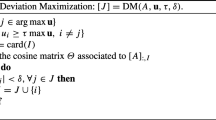Abstract
We introduce a pair of dual concepts: pivoted blocks and reverse pivoted blocks. These blocks are the outcome of a special column pivoting strategy in QR factorization. Our main result is that under such a column pivoting strategy, the QR factorization of a given matrix can give tight estimates of any two a priori-chosen consecutive singular values of that matrix. In particular, a rank-revealing QR factorization is guaranteed when the two chosen consecutive singular values straddle a gap in the singular value spectrum that gives rise to the rank degeneracy of the given matrix. The pivoting strategy, called cyclic pivoting, can be viewed as a generalization of Golub's column pivoting and Stewart's reverse column pivoting. Numerical experiments confirm the tight estimates that our theory asserts.
Similar content being viewed by others
REFERENCES
C. H. Bischof, Incremental condition estimation, SIAM J. Matrix Anal. Appl., 11:2 (1990), pp. 312–322.
T. F. Chan, Rank revealing QR factorizations, Linear Algebra Appl, 88/89 (1987), pp. 67–82.
G. H. Golub, Numerical methods for solving least squares problems, Numer. Math. 7 (1965), pp. 206–216.
G. H. Golub, V. Klema, and G. W. Stewart, Rank degeneracy and least squares problems, Tech. Report TR-456, Dept. of Computer Science, University of Maryland, College Park, MD, 1976.
Y. P. Hong and C.-T. Pan, Rank-revealing QR factorizations and the singular value decomposition, Math. Comp. 58 (1992), pp. 213–232.
S. Chandrasekaran and I. Ipsen, On rank-revealing QR factorizations, SIAM J. Matrix Anal. Appl., 15:2 (1994), pp. 592–622.
C.-T. Pan AND P. T. P. Tang, Bounds on singular values revealed by QR factorizations, Preprint MCS-P332–1092, Oct. 1992, Mathematics and Computer Science Division, Argonne National Laboratory, Argonne, IL, 1992.
D. J. Pierce and R. J. Plemmons, Fast adaptive condition estimation, SIAM J. Matrix Anal. Appl., 13:1 (1992), pp. 274–291.
G. W. Stewart, Rank degeneracy, SIAM J. Sci. Statist. Comput., 5 (1984), pp. 403–413.
G. W. Stewart, Determining rank in the presence of error, in Linear Algebra for Large Scale and Real-Time Applications, M. S. Moonen, G. H. Golub, and B. L. R. De Moor eds., Kluwer Academic Publishers, Dordrecht, 1992, pp. 275–292.
P. T. P. Tang, Dynamic condition estimation and Rayleigh-Ritz approximation, SIAM J. Matrix Anal. Appl., 15:1 (1994), pp 331–346.
Author information
Authors and Affiliations
Rights and permissions
About this article
Cite this article
Pan, CT., Tang, P.T.P. Bounds on Singular Values Revealed by QR Factorizations. BIT Numerical Mathematics 39, 740–756 (1999). https://doi.org/10.1023/A:1022395308695
Issue Date:
DOI: https://doi.org/10.1023/A:1022395308695



